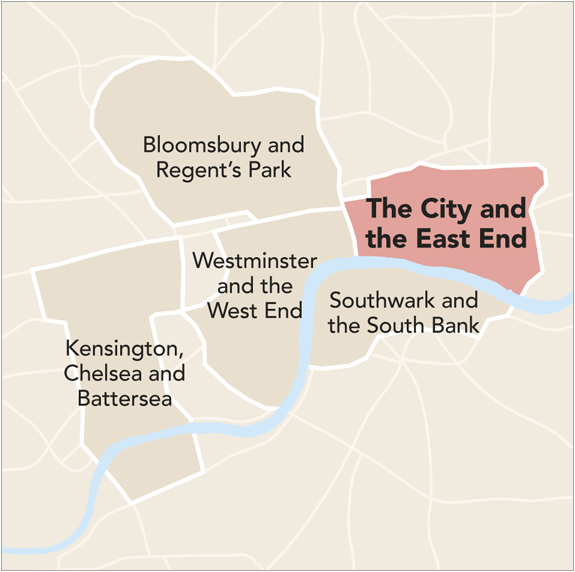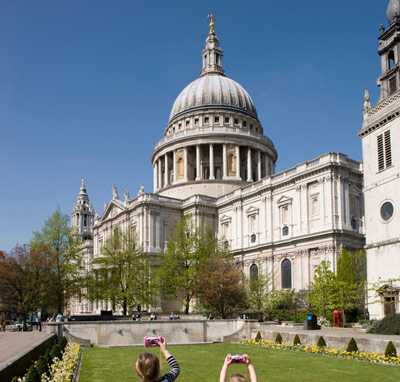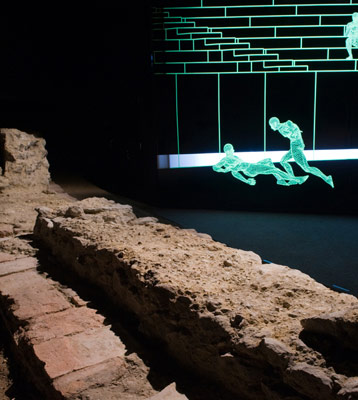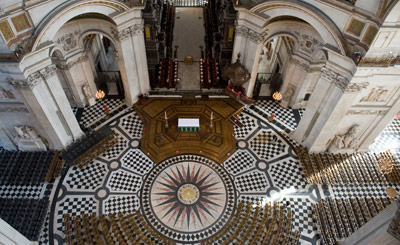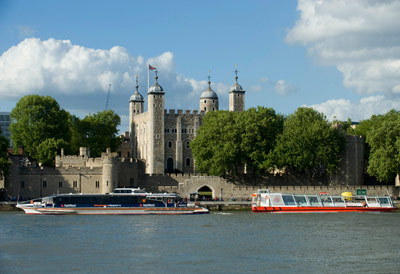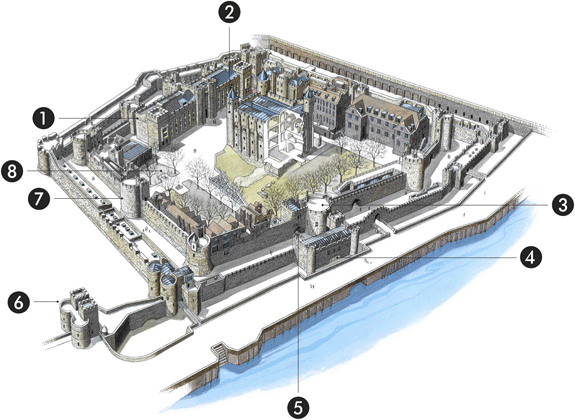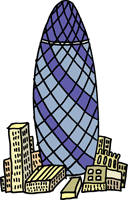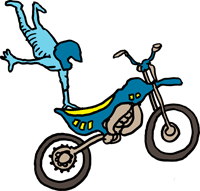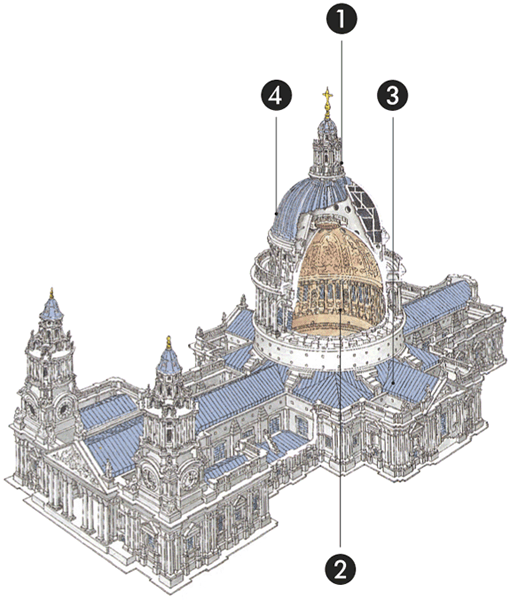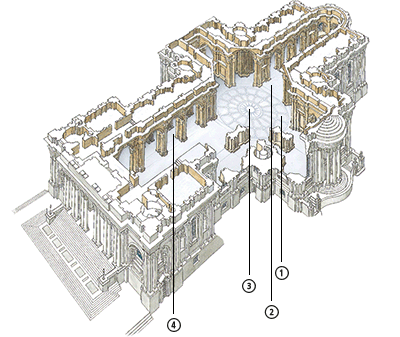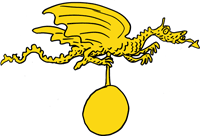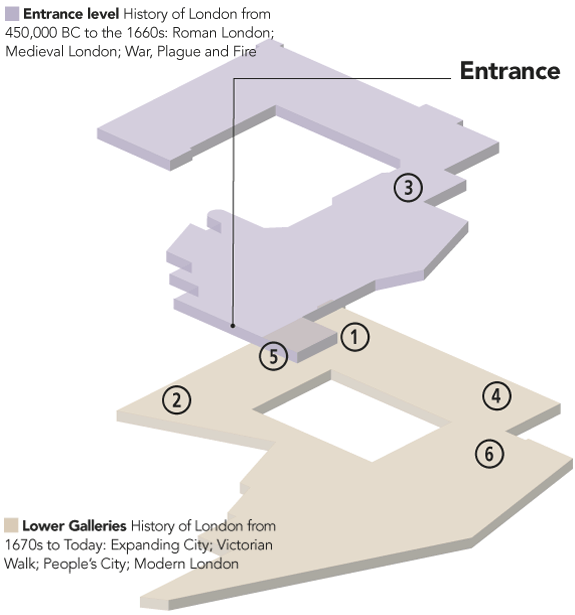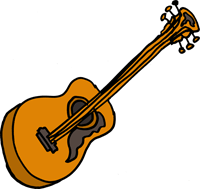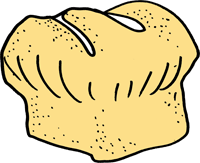< The City and the East End
Tower of London and Around

The enormous Monument, which commemorates the Great Fire of London
Begun in 1078 by William the Conqueror to subdue his new Anglo-Saxon citizens, the Tower of London has extended its special brand of hospitality to the likes of Anne Boleyn, Guy Fawkes and Captain Blood. There’s a full day of family fun here, so book online to skip the queues, and try to avoid weekends. The Tower, the Monument and St Katharine’s Dock all have an outdoor dimension, so this area is good to visit on a sunny day.
1. Tower of London
2. The Monument
3. Leadenhall Market
4. All Hallows by the Tower
5. Tower Bridge
6. St Katharine’s Dock
7. Whitechapel Gallery
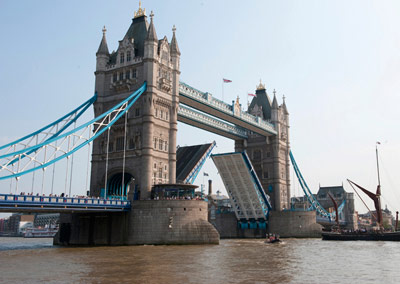
The iconic Tower Bridge, with its pinnacled towers
1. Tower of London
A pop-up-book castle in modern London
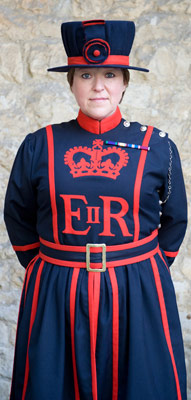
A Beefeater standing guard
With its stories of beheadings, child-slayings and torture, the tower has a gory appeal for kids. There are ramparts to patrol, spiralling staircases, execution sites and chambers full of treasure. The interiors are interactive, too: meet a minstrel in Henry III’s medieval palace, try on a helmet in the Peasants’ Revolt exhibit and fire a crossbow in the White Tower. Touching the Crown Jewels is still banned, however – the last time the guards allowed that in 1671, Colonel Blood tried to stuff them down his breeches.
Key Features
1. Jewel House The Crown Jewels, including the royal sceptre, which holds one of the largest diamonds in the world, are stored here.
2. White Tower This houses Henry VIII’s armoury – visitors can handle the replica weapons.
3. Wakefield Tower This has a rack for stretching, manacles for dangling and the “scavenger’s daughter”, for crushing people to a pulp.
4. Traitor’s Gate Prisoners, many on their way to die, entered the Tower by boat through these gates.
5. Bloody Tower Known as such after the strange disappearance here of 12-year-old Edward V and his 9-year-old brother in 1483. Their uncle, Richard III, was next in line to the throne and is the prime suspect.
7. Beauchamp Tower The walls are etched with prisoners’ graffiti. The inscription “Jane” recalls Lady Jane Grey, who was executed at the age of 17.
8. Tower Green Queen Anne Boleyn, one of Henry VIII’s wives, was beheaded here. She expected a late pardon, so no coffin was made. They buried her in an arrow box.
• The ravens Housed at night, the six ravens are now the only prisoners here. Legend says that if they ever leave, the tower and the kingdom will fall.
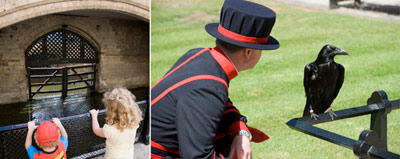
Left
Traitor’s gate Right One of the six resident ravens
Kids’ Corner
Trick a grown-up!
Try this riddle on an unsuspecting adult. Thirteen towers on the inner wall, six towers on the outer wall… how many towers does the Tower of London have in total? Answer: 20. Bet they forgot to count the White Tower in the middle!
Sticky ends
Search the Tower and try to match these prisoners with their fates: beheaded; tortured; pardoned; and escaped…
-
Guy Fawkes Plotter who tried to blow up Parliament
-
Colonel Blood Daring adventurer who tried to steal the Crown Jewels
-
Sir Walter Raleigh Explorer who wrote a history of the world while imprisoned
-
The Earl of Nithsdale Rebel who wanted to overthrow King George I
Stair puzzle
The Tower’s spiral staircases all twist clockwise on the way up. Can you work out why?
The Royal Zoo
Kings often kept exotic animals at the Tower. These included a grizzly bear named Martin, an elephant that drank wine, and a polar bear that liked to fish for salmon in the River Thames.
2. The Monument
Climb up among the rooftops for views over London
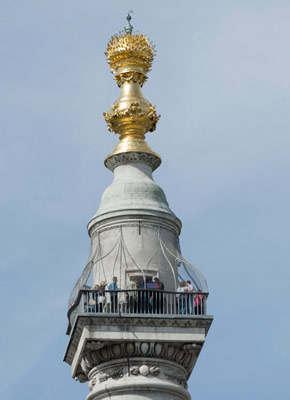
The viewing deck at the top of Wren’s grand Monument
Three centuries before the London Eye, it was possible to admire the city’s skyline from 50 m (164 ft) aloft. The view is hard earned: there are 311 corkscrewing steps to reach the caged platform atop The Monument, erected by Sir Christopher Wren in the 1670s to remember the Great Fire of London.
The fire broke out in September 1666, in a bakery in nearby Pudding Lane, and within three days it had reduced 13,000 homes, 87 churches and St Paul’s Cathedral to ashes. The good news: it also saw off the Great Plague, which had wiped out 100,000 people the year before.
The Monument is still the world’s tallest free-standing column and must have been a marvel in its day. Wren built a laboratory in the basement for conducting his experiments, but soon it was open for visitors. The climb is a challenge for little legs, but well worth it to emerge among the spires and skyscrapers of modern London. The telescope commentaries are hardly worth bothering with; instead, just savour the fabulous views. There is a certificate for everyone who makes it down again intact.
Kids’ Corner
Which is tallest?
Climb to the top of the Monument and look for these famous London landmarks. Can you put them in order, shortest to tallest? Don’t forget that buildings look smaller if they are far away!
-
“The Gherkin”
-
St Paul’s Cathedral
-
Canary Wharf Tower
-
The London Eye
-
Crystal Palace TV Tower
Fire-starter
How can you find the place where the Great Fire of London started? Easy: the Monument is 61 m (202 ft) high – exactly the distance westwards from where the fire started. So if you take 61 big strides eastwards, you’ll reach the spot. Back home, you can help eight-year-old Tom Porter fight the Great Fire of London by logging on to
www.fireoflondon.org.uk/game.
3. Leadenhall Market
From Dick Whittington to Harry Potter
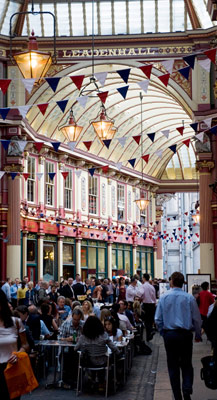
The interior of historic Leadenhall Market, with its bustling cafés
This area has a fascinating 600-year history – and it really looks the part. The warren of cobbled arcades is encased in fancy ironwork and lit by quaint lanterns, while pillars gleam in bold carousel colours – cream, claret and green. Snarling dragons guard every corner and there are topsy-turvy taverns and streetwise shoeshine stands. It’s like looking into a Victorian kaleidoscope.
The centre of Roman London was here – the ruins of its 1st-century basilica, the same length as St Paul’s Cathedral, lie buried beneath the Lamb Tavern. In 1411, the merchant Richard (Dick) Whittington, of pantomime fame, donated Leadenhall to the City of London, and by 1800 it was Europe’s best-supplied market, specialising in beef and game.
The arcades were designed in 1881, and now host gourmet butchers and cheesemongers, slick brasseries and bars, plus Pandora’s Box and Ben’s Cookies for sweet treats. As a family lunch spot, Leadenhall has genuine wow factor – especially when you reveal the Harry Potter connection. Bull’s Head Passage was transformed into Diagon Alley, where our hero buys his wand in Harry Potter and the Philosopher’s Stone.
Kids’ Corner
Goosey goosey gander…
Can you spot the old Victorian meat hooks at Leadenhall Market? Live animals were brought here to be killed and sold. One lucky bird was Old Tom the gander, who escaped the butcher’s block and became the market’s mascot. He died in 1835, aged 38, and lay in state here, for everyone to pay their respects.
4. All Hallows by the Tower
Boudicca, beheadings… and brass-rubbing
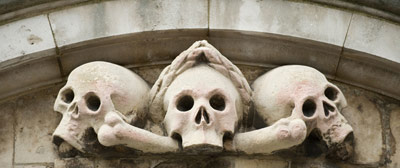
Grim skull and bone reliefs above the entrance to St Olave’s church
London’s oldest church is packed to the tower-top with quirky history, from the battles of Boudicca to beheaded bodies and the glowing embers of the Great Fire of 1666.
Begin in the crypt, where a pristine chunk of 2nd-century pavement was uncovered in 1926, along with a layer of ash dating from Queen Boudicca’s burning of the city in AD 60. There’s also an intricate model of Roman London to look at and scraps of salvaged pottery from imperial days.
Fast forward to Saxon times – an archway survives from the original 7th-century church, revealed suddenly when a bomb blasted the building during World War II. In the 16th century, All Hallows took in the headless corpses from Henry VIII’s execution scaffold (see
Tower of London), including that of Sir Thomas More. The church survived the Great Fire of London thanks to the quick wits of Admiral William Penn (father of Penn of Pennsylvania fame), who blew up nearby buildings to create a fire-break. Meanwhile, Penn’s next-door neighbour, Samuel Pepys, climbed the steeple to watch the blaze – having first buried his prized truckle of Parmesan in his garden.
If that doesn’t impress the kids, they can take home their very own medieval knight – the church’s visitor centre offers brass-rubbing sessions most weekday afternoons.
5. Tower Bridge
The legend of the flying bus driver
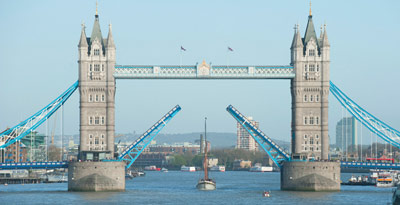
Tower Bridge opening to allow a high-masted boat through
“Tawdry … pretentious … absurd”. When Tower Bridge opened in 1894, the architecture critics didn’t think much of Horace Jones’s flamboyant Gothic design. Today, it is London’s number-one icon, and its drawbridge-style bascules (the “see-saw” parts) are still raised 1,000 times a year to allow ships to pass. The patriotic paint scheme, first added in 1977 to mark the 25th anniversary of the accession of Queen Elizabeth II, used 22,000 litres (4,840 gallons) of red, white and blue paint.
The bridge’s high walkways were designed for pedestrians – but nobody wanted to climb the 300 stairs to use them. Today, an elevator whisks visitors 42 m (138 ft) up onto the twin gantries, for breathtaking views along the river. Little ones may need lifting up to get the full impact, though there’s an Explore Kit to keep them occupied, and stickers to collect en route.
Displays focus on bridge trivia, including stories about straying whales, cheeky fighter pilots and Albert Gunter, the “flying bus-driver”, who found himself airborne in 1952 when the bascules opened while his number 78 bus was still crossing the bridge.
The exhibition continues in the Victorian engine rooms, showing off the shiny steam turbines that powered the bridge until 1976, when oil, electricity and hydraulics took over. Here, kids can get to grips with interactive models: for example, sit an unsuspecting sibling in a chair, turn a handle, and watch them suddenly lurch skywards.
Kids’ Corner
Which bridge?
-
Which of London’s bridges, opened in 2000, was nicknamed the “Wobbly Bridge” because it swayed when people first walked across it?
-
Which famous bridge over the Thames was sold to an American businessman and rebuilt stone by stone in Arizona?
-
Which bridge is nicknamed “Ladies Bridge”, because it was built by women while the men were away fighting in World War II?
Flying high
The most spectacular Tower Bridge crossing ever was by Robbie Maddison, who did a back-flip as he flew across the open drawbridge on his motorbike, 30 m (98 ft) above the river, in 2009. Watch a film of the feat at the Tower exhibition. But that’s nothing. Robbie holds the world record for the longest motorbike jump, at 106.9 m (351 ft) – longer than ten buses!
6. St Katharine’s Dock
London’s floating treasure trove
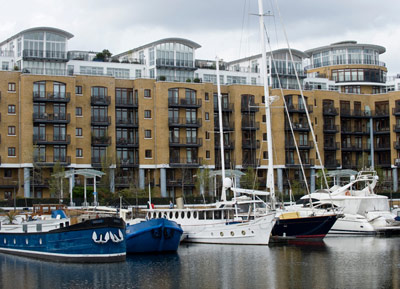
Boats in the pretty marina at St Katharine’s Dock
Hidden behind a phalanx of high buildings, St Katharine’s Dock is one of London’s loveliest backwaters, where a powerhouse of the Industrial Revolution has been transformed into a jaunty marina lined with yachts and waterside cafés. It’s a great place to kick back after tramping around the Tower of London.
The dock’s roots as a shipping hub date back to the 10th century, when King Edgar granted 5 ha (13 acres) to 13 knights, with permission to trade. It grew into a prosperous and important mercantile area over the centuries. In the 1820s, the great civil engineer Thomas Telford built the basins we see today, and their warehouses were stacked high with treasure from across the British Empire – marble, ivory, wine, spices and perfume. As late as the 1930s, St Katharine’s was reckoned to hold the world’s largest concentration of portable wealth.
These days, the warehouses have been turned into office blocks and the money is not in the cargoes, it’s in the boats themselves. For children, a wander among the yachts and pleasure cruisers is a glorious glimpse into life afloat.
Kids’ Corner
Sculpture trail
The sculptures scattered around St Katharine’s Dock hark back to some of the riches that were once traded there. See if you can find a pair of elephants, a peacock and a turtle. Which precious goods do you think these creatures provided?
7. Whitechapel Gallery
Art on the edge

Creating a masterpiece in one of the Whitechapel Gallery’s workshops
Little Miss Muffet is menaced by a malevolent tarantula. A cute teddy bear suffers an extremely grisly disembowelling. When commissioning artists to mastermind a new exhibition for children, Jake and Dinos Chapman may not seem like an obvious choice. But the Whitechapel Gallery likes to push boundaries.
The gallery has been at the cutting edge of contemporary art since 1901, introducing the likes of Frida Kahlo, Jackson Pollock and Gilbert & George to British audiences. In 2009 a £13 million revamp doubled the exhibition space and added a dedicated children’s studio on the top floor. The Chapman Brothers’ 2010 summer show typified the Whitechapel’s thought-provoking approach to art for kids.
The gallery offers free workshops and family days most weekends, and 1–2 day courses (cost varies), inspired and often led by artists. Available all the time is the Make It Yours art detective kit, loaded with scrapbook, stickers and drawing materials.
< The City and the East End
St Paul’s Cathedral and Around
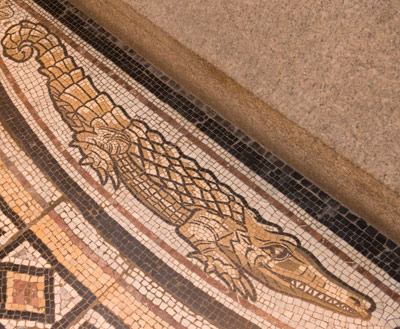
Mosaic of a crocodile at Nelson’s tomb in St Paul’s Cathedral, made by women prisoners at Woking Gaol in the 19th century
Left smouldering by the Great Fire of London in 1666, London’s grandest church owes its modern-day magnificence to the great Renaissance architect Christopher Wren, who spent almost 40 years on his masterpiece. Best visited at the weekend, its most dramatic approach with children is on foot via the pedestrianized promenade from Millennium Bridge. Join a guided walk (free for under-12s) from the nearby City of London Information Centre, then climb the cathedral’s famous dome and enjoy the fantastic views of the city’s skyline.
1. St Paul’s Cathedral
2. Bank of England Museum
3. Dr Johnson’s House
4. Guildhall Art Gallery
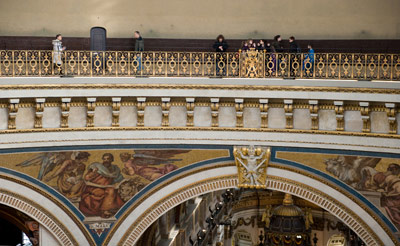
The Whispering Gallery in St Paul’s Cathedral – a whisper against its walls is audible on the opposite side
1. St Paul’s Cathedral
Possibly the most spectacular church in Christendom
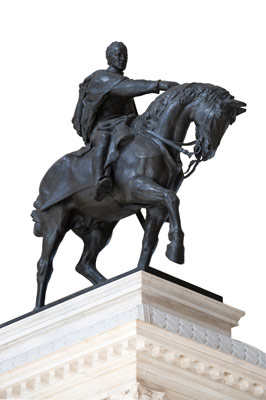
Wellington Monument
Boasting Britain’s biggest bell, Europe’s largest crypt and a dome weighing 64,000 tonnes, St Paul’s is a superlative building. Its shadowy crypt is full of famous memorials, including those of the Duke of Wellington, Florence Nightingale and Admiral Nelson, but what children will adore is counting the steps to the Whispering Gallery, and the magical sound effects they can create there. The family audio guide keeps things fun, with cartoons, quizzes and nuggets of trivia designed to dazzle even grown-ups.
Key Features
1. Golden Gallery Lying at the highest point of the dome, it’s a pull up all those steps. It’s worth the effort – visitors are rewarded with a spellbinding view across London at the top.
2. Whispering Gallery The quirky acoustics inside the spectacular dome throw a whisper all the way around the walkway, making this an atmospheric echo chamber kids will love.
3. Old St Paul’s The old cathedral, at 149 m (489 ft), was taller than the new one (111 m/ 364 ft), as a model in the crypt shows.
4. The Dome It’s as heavy as 50,000 elephants, so Wren cleverly designed a dome within a dome, to bear the weight. As it was built, he was hauled up in a basket twice a week to inspect it.
Key Features
1. Florence Nightingale’s Memorial The hospital reformer first came to prominence as a nurse during the Crimean War (1853–6). She was the first woman to receive the Order of Merit.
2. Oculus This exciting multimedia show, in the former Treasury in the crypt, brings the cathedral’s 1,400 years of history to life.
3. Nelson’s Tomb Buried in a coffin hollowed out of the mast of a defeated French flagship, Horatio Nelson gets star billing in the centre of the crypt. Look for seafaring symbols in the mosaic floor.
4. Wellington Monument This tribute to one of Britain’s most famous soldiers is in the North Aisle. He died in 1852 – his tomb is in the crypt.
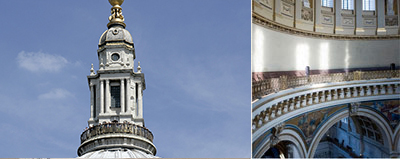
Left
Golden Gallery Right Whispering gallery
Kids’ Corner
Can you find…?
Look for monuments to these once unlikely heroes…
- The Duke of Wellington’s boyhood talent was the violin. His mum thought he would make a terrible soldier, but he became Britain’s greatest general.
- Florence Nightingale’s family was so rich that she didn’t dress herself or brush her own hair until she was 30 – she later found fame caring for others.
- Winston Churchill was very naughty at school – when his first teacher arrived, he ran and hid in some bushes. He became a brave war leader.
Gone with a bang
During the Great Fire of London, the cathedral’s statues got so hot that some exploded. Can you find one that survived the fire intact? Look for the scorch marks.
One, two, three…
Here’s how many steps you must climb to reach each gallery in St Paul’s dome. Add them together to work out the total number right to the top. You’d better check your answer. Up you go, start counting!
| Whispering Gallery |
259 steps |
| Stone Gallery |
119 steps |
| Golden Gallery |
150 steps |
| Total to the top = |
|
Did you know…
Copenhagen, the Duke of Wellington’s horse, was famous, too – ladies wore brooches made from his hair. When he died, he was given a full military funeral.
2. Bank of England Museum
Crack a safe, grab some gold
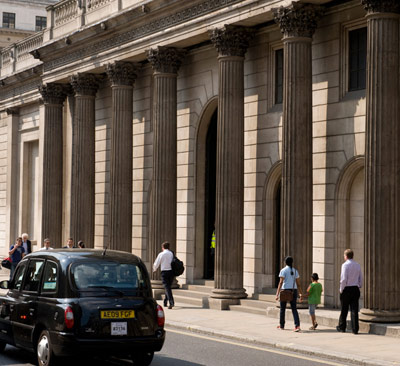
The Sir John Soane-designed building housing the Bank of England Museum
Walking into the grand hall of this museum is one of the more surprising experiences in London. There are kids everywhere: piloting hot-air balloons, designing bank notes, cracking safes. This playroom approach strives to make simple economics palatable to young minds – never an easy task.
The hot-air balloon works as an effective metaphor for the nation’s finances and kids can get their hands on the controls. Nearby, there’s a safe to unlock with the help of quiz answers gathered from around the room.
The rest of the museum is more sober and includes a £1 million note and a gold ingot worth more than £300,000, which children can try their hand at lifting. Look out for the showcase featuring Ratty and Mole, creations of Wind in the Willows author Kenneth Grahame (1859–1932), who was secretary to the bank from 1879 to 1908.
3. Dr Johnson’s House
The home of an English eccentric
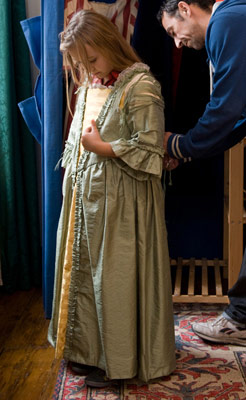
Dressing up in period costume in Dr Johnson’s House
He collected orange peel, wore the same clothes for weeks, and liked to start every journey with the same foot. But the eccentric Samuel Johnson was a London legend, and the great and the good gathered at his house off Fleet Street to enjoy his witty conversation. Today, Dr Johnson is remembered mainly for his English dictionary, compiled here in the 1750s, with a team of scribes who copied literary snippets to illustrate 42,000 definitions. It took nine years to write, during which the debt-ridden Johnson once had to barricade the door with his bed to fend off bailiffs.
Johnson’s jokes will fly over the heads of most children, but there is a film telling his story and a dressing-up rack of Georgian frockcoats to try on. Point out the spiked window above the door, to deter burglars from smuggling boy accomplices inside; and challenge kids to track down Hodge, Johnson’s spoilt cat. Clue: he’s out on the tiles.
Kids’ Corner
Strange Sam
Dr Samuel Johnson was very eccentric. He borrowed his friends’ books to find words for his dictionary – then scribbled all over them! Erasers hadn’t been invented! So what do you think he used to try to rub out the pencil marks?
-
a A lump of coal
-
b Breadcrumbs
-
c Orange peel
4. Guildhall Art Gallery
Where gladiators fought
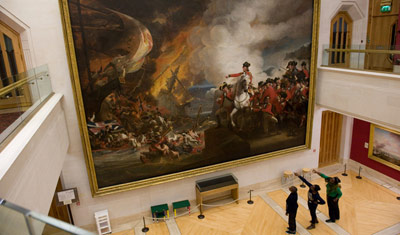
The Siege of Gibraltar, one of the UK’s biggest paintings, at the Guildhall Art Gallery
Dragons, Dick Whittington, Britain’s biggest painting and a ruined Roman amphitheatre – these are just some of the unlikely attractions at the Guildhall Gallery. It stands beside the 15th-century Guildhall, seat of City government since medieval times, whose courtyard has a statue of Dick Whittington, every child’s favourite Lord Mayor. The yard is menaced on all sides by dragons, the City’s armorial emblem – ideal for a game of I-Spy.
The gallery itself is dominated by John Singleton Copley’s eye-popping painting The Siege of Gibraltar (1791) – so big that it occupies two floors. Youngsters may prefer the Undercroft Galleries downstairs, lined with sentimental Victorian pictures of children, including John Everett Millais’ funny portraits of his daughter dozing off in church.
The main reason to come here, though, lurks in a dark cavern in the basement – the ruins of London’s 2,000-year-old Roman amphitheatre, stumbled upon by archaeologists in 1988. In Roman times, up to 6,000 people sat here to watch bloody animal fights, public executions and gladiatorial combat – to the death. Scant foundations survive, but children won’t notice that, because spotlights and sound effects do a brilliant job of bringing the arena to life. Stride in through the eastern entrance, as gladiators once did long ago, past the pens used to hold wild beasts, and listen to the deafening roar of the crowd.
Kids’ Corner
True or false?
In the fairytale, Dick Whittington was a poor orphan who found fortune thanks to his rat-catching cat and became Lord Mayor of London. But not everything in the story really happened. Which of these do you think is true to history?
-
He was a poor orphan
-
He became “thrice mayor of London”
-
He owned a cat
Hunt the Dragon!
Dragons are the mascots of the City of London – they’re everywhere around here! Score a point for each one you spot at the Guildhall, and collect more points if you can find these unusual banking signs as you walk along nearby Lombard Street.
Giant grasshopper (3 points)
Cat playing the fiddle (5 points)
A golden anchor (10 points)
< The City and the East End
Museum of London and Around
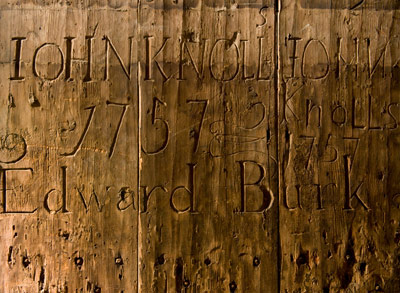
Prisoners’ elegant graffiti in an 18th-century cell at the Museum of London
A £20 million revamp has made the Museum of London a supremely welcoming place for families, from the pink-shirted “hosts” to the hands-on exhibits that animate London’s story. Arrive on foot along Aldersgate Street from St Paul’s tube station, and take the escalator on the right-hand pavement. Weekends are the prime time to visit, when there are fewer school parties, free family events on Sundays and children’s films every Saturday at the nearby Barbican. To combine the museum with Old Spitalfields Market, take the Hammersmith & City line from Barbican to Aldgate East.
1. Museum of London
2. The Barbican
3. Old Spitalfields Market
4. Museum of the Order of St John
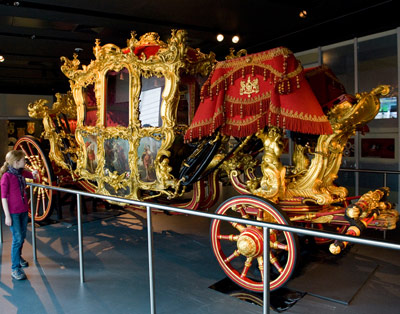
Built in 1757, the Lord Mayor’s state coach in the Museum of London is beautifully crafted and still used for the Lord Mayor’s Parade
1. Museum of London
Don’t touch? Don’t be so old-fashioned!

Nursery Garden at the Museum of London – one of two small gardens
It’s not easy to bring 450,000 years of history to life for children, but the Museum of London does just that, using a mix of interactive gadgetry and eye-catching presentation. The upstairs rooms are arranged chronologically and are packed with prehistoric skulls and Roman treasures, while the Galleries of Modern London resemble a series of spectacular stage-sets – including a shadowy Georgian prison cell and a Victorian high street. The excellent activity trails and backpacks encourage kids to explore.
Key Features
1. Victorian Walk Window-shop along a lively Victorian high street, complete with toy shop, pub, bank and barber’s shop. The fixtures and fittings are all original.
2. Wellclose Prison Cell Enter the dark, claustrophobic cell from a 1750 debtors’ prison, its walls scratched with the names of desperate inmates and echoing with their pleas for mercy.
3. Archaeology in Action Get to grips with ancient pottery and other precious booty found in London at the artifact-handling sessions.
4. Evacuees’ Trunks Lift the lids to read real-life letters from schoolchildren on the eve of World War II – and discover what they packed for their flight from London.
5. Georgian Pleasure Gardens Explore this re-creation of an 18th-century park, with its harlequins, acrobats and elegant ladies in fancy hats. Children were expected to behave like miniature adults.
6. Bill and Ben Find out what children’s TV was like in the 1950s, by exploring the wall of toys and TV screens in the museum’s Playtime Zone.

Left
Georgian pleasure gardens Middle Archaeology in action Right Victorian toy shop window
Kids’ Corner
Kill or cure
Medieval doctors had strange ideas about how to cure the sick, even tasting patients’ wee to find out what was wrong with them! Match these ailments with their medieval medicines:
-
Bad eyesight
-
Headache
-
Plague
-
Possession by demons
-
a Wild poppies
-
b Leeches
-
c Lettuce juice
-
d Dried toad
In the closet
The museum’s collection has some amazing things – from 17,000 skeletons to 1,000 penny toys that belonged to a man called Ernest King when he was a boy. Some are in the toy shop in the Victorian Walk. Do you have any toys the museum might want one day?
Toy trail
Find more historic toys in the downstairs galleries, and answer the questions here:
-
What’s for dinner at the Blackett’s Dolls’ House?
-
What colour are Daisy the Fashion Doll’s boots?
-
What is the name of Bill and Ben’s friend in the children’s TV programme?
On the tiles
Make your own mosaic like the one in the Roman dining room. Take five sheets of coloured paper and cut them into small triangles and squares. Now make your own pattern from the pieces and glue it down. Can you make a bird, a love-heart or a flower?
2. The Barbican
Cartoons and crazy art
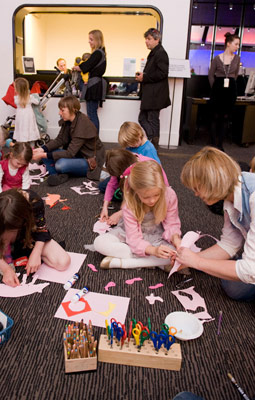
Ensconced in the Saturday Film Club at the Barbican
If you’re looking for somewhere to lose the children, the Barbican might just be it. With its innumerable entrances and tangles of stairways and courtyards, Europe’s biggest multi-arts complex is a little difficult to navigate. Never fear – head for the main entrance round the back on Silk Street, which curves down into the heart of things.
Inside is a vast black-and-orange bunker packing in two theatres, two art galleries, a music and dance space, a library, three restaurants and three cinemas. There is always something happening and it’s often for kids, from the Family Film Club every Saturday morning to a fistful of annual festivals, including the London Children’s Film Festival in November and Animate the World in May. The Curve Gallery on Level 0 showcases the kind of conceptual art that’s guaranteed to excite the imagination of children, and the library on Level 2 also has a great children’s section.
Check the website to find out what’s on, or just drop in and enjoy the food hall, overlooking an urban lake with lily-pads and a waterfall.
Kids’ Corner
Guitar heroes
The Barbican is famous for its novel art shows, which have included a full-size roller-coaster, a World War II bunker and a London taxi with holes drilled through it. The strangest show of all was by the French artist Celeste Boursier-Mougenot. He filled a gallery with guitars and cymbals and 50 zebra finches. The birds would land on the instruments and “play” them with their claws and beaks. That’s what you call air guitar!
Movie mayhem
The Barbican’s Family Film Club website has some great online games. Help Dick Whittington to rid London of rats, or race your “Moviesaurus” dinosaur across a plain full of pesky predators:
www.barbican.org.uk/ffc07/games-and-activities.
3. Old Spitalfields Market
London’s liveliest and coolest market place
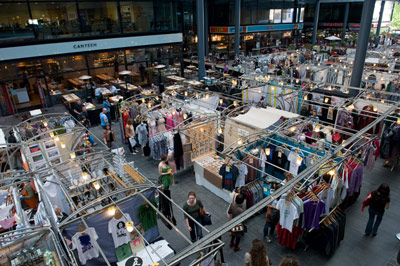
Bustling Old Spitalfields Market filled with a variety of stalls
The first market at “Spittle Fields” was licensed to sell flesh, fowl and roots by King Charles I in 1638, but the area’s wholesale green-grocers outgrew the site in 1991, paving the way for an inventive community of craftspeople and designers to move in.
Today, Spitalfields Market is cutting-edge cool and on a busy Sunday up to 1,000 traders specializing in vintage fashion, bespoke jewellery and gifts set up stalls. The vibe is youthful and positive – a winner with fashion-conscious kids. Stalls operate every day except Monday and Saturday, but Sunday is when things really get going.
Don’t miss a browse among the offbeat boutiques that have popped up in adjoining streets, too – including Wood ‘n’ Things (57 Brushfield Street, E1 6AA), for high-quality toys and dolls, traditional wooden toys, wellcrafted doll’s houses, train sets, as well as sit-and-ride toys. The market’s “food village” serves aromatic dishes from the world over, while a fine foods market runs on Thursday, Friday and Sunday in nearby Crispin Place.
Just south of Old Spitalfields, along Middlesex Street, lies historic Petticoat Lane Market, a more down-to-earth affair where traders have been shouting their wares since the 1750s – mostly street clothing, leather goods and shoes.
Kids’ Corner
Slanging match
Traders at Petticoat Lane Market use Cockney rhyming slang. “Stairs” becomes “apples and pears”; “phone” is “dog and bone”. Can you work out what these bits of rhyming slang mean? Clue: they are all parts of the body…
-
Plates of meat
-
Mince pies
-
Loaf of bread
-
Boat race
-
Barnet Fair
Knickers in a twist!
Why isn’t Petticoat Lane Market on Petticoat Lane? In the 1830s the name of the road became Middlesex Street, because some people thought it rude to have a street named after underwear!
4. Museum of the Order of St John
From nurses to knights
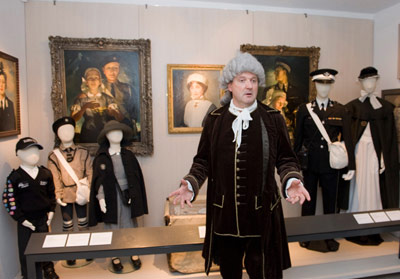
Costumed guide at the Museum of the Order of St John
There’s something distinctly magical about visiting the historic home of real knights in the heart of London. The building certainly looks the part – built in 1504, it is a remnant of the priory of the Knights Hospitaller, the medieval crusaders who went from helping sick pilgrims in Jerusalem to fighting Saladin.
The museum uses TV screens, armour and artifacts to relay its stirring story of chivalric sacrifice. A separate gallery is devoted to the St John’s Ambulance movement, the 20th-century reincarnation of the order, still based here. It may be fairly conventional, but the museum succeeds in bringing history to life.
